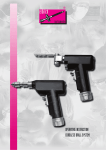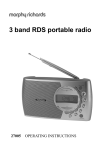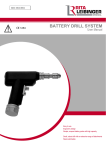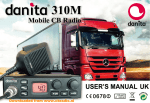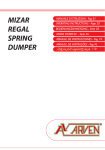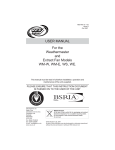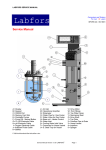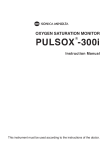Download MAT 4-807 User`s manual
Transcript
MEDICAL ADVANCED TECHNOLOGY 1253 CORDLESS DRILL SYSTEM User’s Manual No. 6.1 ( GB ) CORDLESS SYSTEM Easy to use Ergonomic design Simple, compact battery packs with high capacity Small, robust drill with an extensive range of attachments Steam-sterilisable Intended use: The Drill 4-807 is used in bone surgery for drilling and tapping, inserting and removing screws and placing Kirschner wires. The drill has a cannulated drive shaft, so that drill wires can be briefly inserted and fed through the drill (diameter of cannulation: 3.2mm) for safe working. The tool holders (attachments) permit quick and easy chucking of the required tools. A choice of chucks and holders (attachments) ensure compatibility with various tool ranges. Warning! Only attachments from MAT GmbH&Co.KG are approved. If attachments from other manufacturers are used, we will not give any warranty. Mixing of components from other manufacturers is not permitted! Method of operation: The electric motor of the Cordless Drill 4-807 is powered by a rechargeable battery and delivers 0-750 rpm with infinitely variable electronic speed control. The Cordless Drill has triggers labelled R and L. Lower trigger L = double function: main switch and reverse rotation. Upper trigger R = nfinitely variable clockwise rotation. Press both triggers and regulate the speed with the upper trigger. The Cordless Drill switches off automatically if not used for approx. 5 minutes. If this happens, first press the lower trigger L again and release it. Then press only the upper trigger R for infinitely variable clockwise rotation. For infinitely variable reverse rotation, hold down both triggers R and L. Specifically, reverse rotation is required for rocedures such as releasing bone screws and removing Kirschner wires. Reverse rotation must be used exclusively for the above-mentioned procedures. Note: The Rechargeable Battery 4-810 does not require sterilisation, but must be treated with the same care as a surgical instrument, even though it is not categorised as a medical device. Preparing for use: To use the Cordless Drill 4-807, you require the following items: • Desktop Charger 4-814 or 4-816 (for rapid charging of the Battery 4-810) • Rechargeable Battery 4-810 • Cordless Drill 4-807 • Appropriate attachments for the planned procedure Before using the Cordless Drill for the first time, please ensure that you have the necessary attachments. You will need the Charger 4-814 or 4-816 and at least one Battery 4-809 or 4-810. Note: Before using the Charger 4-814 or 4-816, read the accompanying instruction manual. Functional check: Before using the Cordless Drill, always test it with the appropriate attachments fitted. Briefly operate the Cordless Drill in both directions of rotation. Ensure that the attached chuck (attachment) and the required tool are properly connected to the Cordless Drill, and check for correct direction of rotation and smooth running (wobble if not correctly connected). For this functional check, first insert a charged Battery 4-810 into the Cordless Drill. 2 Cleaning, disinfection, sterilisation: Cleaning and disinfection Wipe the surfaces immediately after use with a lint-free cloth moistened with a cleaning agent or disinfectant, or use a disinfectant spray, to prevent exudates or other contamination from drying on. For this manual wipe--down, use a cleaning agent or disinfectant approved for surface disinfection under national regulations (DGHM – German Association of Hygiene and Microbiology). Please follow the manufacturer‘s instructions for correct dilution, exposure time etc. In the case of heavy contamination, the Cordless Drill 4-807 can also be cleaned under running water (machine cleaning is not permitted). Note: Excessive exposure to saline solutions or solutions containing iodine or chloride may cause harmful reactions. Damage may also be caused by strong acids and alkaline solutions or incorrectly used disinfectants. The quality of the water used for cleaning and rinsing is another possible factor affecting corrosion or surface damage for the drill and attachments. The Cordless Drill 4-807 must never be immersed in water or cleaning solutions, or boiled. Always close the cap of the Cordless Drill 4-807 before cleaning! CAUTION! Machine cleaning and ultrasonic cleaning in thermodisinfectors are not permitted! Disinfection is required after every surgical intervention to destroy microorganisms. Today, health professionals and patients are at constantly increasing risk, so appropriate cleaning and disinfection of these drills and attachments is extremely important. If in doubt, contact MAT GmbH&Co.KG and the manufacturer of the disinfectant and cleaning agent used! Note: Please observe the “Instructions for use of attachments” (with the exception of the Rechargeable Battery 4-809/4-810 and Desktop Charger 4-814/4-816 ). See the section “Cleaning, disinfection and sterilisation of attachments”. Sterilisation: The Cordless Drill 4-807 with end cap and funnel can be sterilised at up to 2 bar at 134°C in the steam steriliser. It is advisable to place the equipment on a cloth or wrap it in a cloth to prevent external or internal damage. To ensure proper sterilisation, the end cap must be screwed onto the Cordless Drill 4-807. CAUTION! The Rechargeable Battery 4-810 must never be sterilised because if it is heated to above 65°C, it will be irreparably damaged. Maintenance: The Cordless Drill 4-807 itself requires no maintenance. Nevertheless, we recommend annual inspection. This must only be entrusted to the manufacturer or qualified persons authorised by the manufacturer. The maintenance interval depends on the number of times the Cordless Drill 4-807 is sterilised. Note: The battery compartment of the Cordless Drill 4-807 has a watertight cap that also keeps out germs. You should, therefore, regularly inspect the sealing ring on the cap and the sealing surface on the handle. 3 Transport and storage conditions: To prevent damage! The Cordless Drill 4-807 and attachments must be transported in such a way that no damage can occur. This particularly means ensuring suitable packaging. The same attention must be paid to correct storage. This device must only be kept in a dry, closed place! Safety instruction: Remove the battery from the Cordless Drill 1. Before sterilisation 2. If any fault occurs 3. For transport or storage when not in use 4. Before sending for servicing If, for any reason, the drill is stored or transported differently, this may result in damage which is not covered by the manufacturer’s or dealer’s warranty. Troubleshooting: Fault Cause Symptom Motor runs too slowly or torque NiMH battery is to weak is to low Lower trigger not pressed NiMH battery is defective or depleted Recharge Battery 4-809/4-810 Inspect Charger 4-814/4-816 If necessary, change the battery NiMH = nickel-metal hydride Motor does not run Motor defective Control system defective Trigger switch defective Gears or friction bearing defective Rectification No sound when trigger is Send to manufacturer for repair pressed (R or L trigger pressed) Remark: The lower trigger has a double function: main switch and reverse rotation( upper trigger = clockwise rotation) Drill cannot be switched from Solenoid switch (trigger) defec- Reversing function does not Send to manufacturer for repair reverse to clockwise rotation tive react Control system defective Continuous running or wrong direction of rotation Repairs: MAT GmbH&Co.KG only accepts responsibility for the safety, reliability and performance of the Cordless Drill 4-807 if • the Cordless Drill 4-807 is used in compliance with the instructions in the User’s Manual. • installation, additions, adjustments, modifications and repairs are carried out by MAT GmbH&Co.KG or by qualified persons expressly authorised by MAT GmbH&Co.KG. Only original spare parts from MAT GmbH&Co.KG may be used for repairs. The operator is required to obtain a list detailing the type and scope of work performed, with the company stamp, date and signature of the repairer. SERVICING: We recommend sending the Cordless Drill 4-807 to MAT GmbH&Co.KG for servicing after a year or after 120 sterilisation cycles (surgical operations). WARNING! All equipment must be cleaned and sterilised before sending for servicing! 4 Technical data: Type of equipment: Type BF Cordless Drill 4-807 Mono Block Battery oscillating Saw 4-808 Voltage 9,6 V 9,6 V Rated capacity of the Rechargeable Battery 4-810 1.2 Ah 1.2 Ah Speed, infinitely adjustable 0-750 rpm 0-14000 rpm Max. torque 4 Nm Weight incl. battery 1250 grams 1500 grams Motor output 70 W 70 W IP66 IP66 Type according to Directive: EN 60601-1-2 EN 60601-1 / IEC 601-1 MED.UMW Degree of protection, as per DIN EN 529 => Electromagnetic compatibility (EMC): Manufacturer’s certificate: It is hereby certified that the Cordless Drill 4-807/ 4-808 has been tested and is interference-suppressed in compliance with the EMC provisions of EN60601-1-2. This Cordless Drill 4-807 / 4-808 has been tested by our notified body for a Class II.a product with internal or external energy source, as per 93/42 EEC Annex II.3 Tested in accordance with: • • EN 60601 - 1 / IEC 601-1 EN 60601 - 1 - 2 / DIN EN 60601-1-2 Medical electrical devices: • EN 1455 (Clinical data: evaluation of evidence on the basis of literature and a clinical trial MEDDEV 2.7.1) • EN14971 ( Risk analysis: evaluation of risk analysis) • Evaluation of the check list of Fundamental Requirements for this medical device Attachments: Description Order of Number REF.: Cordless Drill with end cap 4-807 Medical Device Mono Block Battery oscillating Saw 4-808 Medical device Long rechargeable battery,with extension 4-809 Medical device Standard rechargeable battery 4-810 Medical device 4-811 Medical device Funnel for inserting rechageable battery into Cordless Drill 4-807 Desktop Charger, mono 240/115 V - charging time 60 minutes 4-814 / 4-815 Not a medical decice Desktop Charger, dual 240/115 V - charging time 60 minutes 4-816 / 4-817 Not a medical decice Three-jaw chuck up to dia. 7.0 mm Round and triangular shanks With chuck key 4-830 Medical device Reduction gears with AO standard clutch, large Speed 0-150 rpm 4-834 Medical device Oscillating saw; AO connection for saw blades AO connection 4-836 Medical device Sternum saw 4-837 Medical device Quick-action chuck for drill wires up to dia. 2.5 mm 4-842 Medical device Protection & guidance sleeve for Kirschner wires 4-843 Medical device AO chuck 4-862 Medical device Din Chuck (Aesculap medullary reamer) 4-864 Medical device Harris chuck 4-866 Medical device Hudson chuck 4-868 Medical device 5 Disposal: MAT GmbH & Co. KG will dispose of the Cordless Drill 4-807 and atttachments (without any environmental contamination)in accordance with the provisions of MED. UMW MAT GmbH & co. KG will deal with disposal! Key to the symbols: Symbol description: R= clockwise rotation L= reverse rotation 6 Symbol 1 Observe instructions in User´s Manual! Symbol 2 Classification Type BF Symbol 3 Recyclable Symbol 4 CE 1253 in accordance with Directive 93/42 EEC Symbol 5 Protection class II device OVERVIEW: 1 6. Clockwise rotation 7. Main switch and reverse rotation R L 2 1. Cordless Drill 2. Battery Compatment 3. Rechargeable Battery 4. End cap 5. Chuck with Drill Bit 6. Clockwise Rotation 7. Main switch and reverse Rotation 3 4 Important To obtain full power from the drill during the surgical operation, always use freshly charged batteries. Preparation Step 1. Open the end cap (4) by turning in the direction indicated by the arrow Step 2. Insert the rechargeable battery (3) into the battery compartment (2) in the direction shown by the arrow, at an angle of not more than 10° to 15°. (insert gently to avoid damaging the contacts) Step 3. Replace the end cap (4) and close it by turning in the direction indicated by the arrow Step 4. Test the drill to ensure it operates properly (see “Method of operation” and “Functional check” on page 2.) 7 Overview of attachments: NOTE: All the clutches and chucks for the Cordless Drill system are mounted in the same way! • Step 1. Slide the clutch collar (1) in the direction indicated by the arrow • Slide the chuck (2) onto the shaft (3) as far as it will go • Release the chuck collar (1) • Turn the chuck slightly until it engages in the shaft (3) • Check the connection • Hold the chuck (4) with your left hand and pull it away from the drill Fault Clutch does not engage in shaft Rectification <=> If due to dirt, clean the clutch; if due to damage, send to Customer Service 1 3 4 2 8 ATTACHMENTS FOR CORDLESS DRILL 4-807 ( GB ) Overview of attachments: Order number Description: 1.) REF. 4 – 809 Long rechargeable battery with extension for Cordless Drill 4-807 for increased power output 2.) REF. 4 – 810 Standard rechargeable battery 3.) REF. 4 – 811 Funnel for inserting Rechargeable Battery 4-809 or 4-810 into Cordless Drill 4-807 (to avoid contamination of the Cordless Drill. If it is not used, there may be a loss of sterility) 4.) REF. 4 – 814 Desktop Charger, mono 240V and 115V: charging time 60 minutes (Please state required voltage when ordering) 5.) REF. 4 – 816 Desktop Charger, dual 240V and 115V: charging time 60 minutes (Please state required voltage when ordering) 6.) REF. 4 – 830 Three-jaw chuck, 0.5 mm to 7.0 mm capacity for round and triangular shanks, incl. chuck key 7.) REF. 4 – 834 Reduction gears with AO standard clutch, large. Speed 0-150 rpm 8.) REF. 4 – 836 Oscillating saw with AO connection for saw blades 9.) REF. 4 – 837 Sternum saw 10.) REF. 4 – 842 Quick-action chuck for Kirschner wires, dia. 0.5 to 3.0 mm 11.) REF. 4 – 843 Protection & guidance sleeve for Kirschner wires (screws onto Cordless Drill 4-807 ) 12.) REF. 4 – 862 Chuck for AO and Aesculap attachments, Standard small 13.) REF. 4 – 864 Chuck for DIN attachments (Aesculap medullary reamer) 14.) REF. 4 – 866 Harris chuck 15.) REF. 4 – 868 Hudson chuck 16.) REF. 4 – 870 Diamond reamer chuck 9 Cleaning, disinfection and sterilisation of attachments: (except Rechargeable Battery 4-809/4-810 and Desktop Charger 4-814/4-816, because these products are not categorised as medical devices ) CLEANING AND DISINFECTION: CARE AND MAINTENANCE Care and maintenance are vital to keep the attachments in good condition and fully functional! Causes of corrosion with stainless steel used for instruments. Corrosion is damage or wear that can be caused by a chemical reaction, e.g. due to: 1.) Damaged surfaces 2.) The effect of surgical exudates: blood, suppuration or bodily secretions in prolonged contact with instruments. 3.) Excessive exposure to certain solutions: saline and iodine solutions, chloride and strong acids, alkaline solutions and incorrectly used disinfectants 4.) Poor water quality when cleaning, steam-sterilising or rinsing instruments and attachments: e.g. due to rusty water pipes or penetration of rust and metal particles into steam sterilisers. 5.) Inadequate maintenance of instruments and accessories: If rust forms, it may be transferred to other instruments and attachments (avoid contact at all costs because it is very dangerous for sterilisation). Constant use of instruments and attachments constitutes natural wear, which shortens the service life correspondingly. Instruments and attachments that are used often should be replaced at regular intervals. MEASURES TO PREVENT CORROSION: 1.) Careful laying out of correctly packaged and sterilised instruments before the operation: selection according to the type of i n tervention. Always ensure that the outer packaging is intact and the expiry date has not elapsed. 2.) Check the sterilisation indicator inside the tray to ensure that the contents have been sterilised. 3.) Arrange the instruments and attachments according to the sequence of use during the operation: if any instruments are not needed, leave them in the tray; only prepare instruments and attachments a short time before the operation. 4.) Remove blood and other exudates from instruments and attachments during the operation: replace instruments and attachments. in their assigned place after use. 5.) Flush through cannulated instruments to prevent blood and bone powder from drying on. 6.) Use Ringer‘s lactate solution or saline solution to clean instruments and accessories, but do not immerse them in solutions. 7.) Start cleaning immediately after the operation: instruments and attachments used during the operation are regarded as contaminated. Instruments used on patients with possible infections must be similarly disposed of; wipe off any blood, bone powder and tissue remnants. 8.) Clean instruments in a designated place within the surgery department. If the instruments are sent directly to the central sterilisation area, first cover them up to prevent any risk of contamination for staff or the environment. Wear protective clothing when disposing of contaminated instruments and attachments! DISMANTLING FOR CLEANING: Instruments and attachments with removable parts should be dismantled. Keep all screws, nuts, bolts and other small parts together, ensuring it is clear which instrument they belong to. The persons responsible for dismantling and reassembling instruments should be appropriately trained. Clean the individual parts to remove any remaining blood or bone powder and prevent drying on during sterilisation and consequent irreparable damage. DISINFECTION: When using chemical disinfectants, the manufacturer’s instructions must be strictly followed: but always dilute solutions before use. For thermal disinfection with hot water, the water must be free of foreign bodies. Please note: Instruments and attachments made of anodized aluminium should not come into contact with certain disinfectant solutions or cleaning agents, so always check the solution before use to avoid subjecting the metal to a chemical reaction. CLEANING: Whether cleaning mechanically or manually, check carefully which cleaning agent is used with which method. Always observe the instructions for dilution and use. Recommended pH: between 7.0 and 8.5. 10 1. MECHANICAL CLEANING: Mechanical cleaning is the preferred method. Strictly follow the instructions supplied by the manufacturer of the cleaning machine. Prepare the instruments and attachments for mechanical cleaning. Multipart instruments and attachments that can be dismantled must be taken apart or opened for cleaning. All tips and delicate parts should be cleaned manually. Do not overfill wire trays; place heavy parts on the bottom of the tray. Heavily contaminated parts (cannulated instruments and attachments) may need soaking and flushing through before they are put in the washing machine. 2. ULTRASONIC CLEANING (classified as a type of mechanical cleaning): Remove excess exudates before placing instruments or attachments in the ultrasonic bath. Ultrasonic baths are recommended, e.g. for taps or instruments and attachments with deep grooves. Ultrasonic cleaning must be followed by normal rinsing. 3. MANUAL CLEANING: Requires various nylon brushes, blowing tube and nozzle, clean compressed air device, cleaning agents and solvents as for mechanical cleaning. Observe the manufacturer’s instructions for cleaning additives! Do not use steel wool or wire brushes. Treat anodized aluminium with extreme care. Any residues remaining after brushing must be removed completely. 4. DRYING: Every instrument and attachment must be completely dried inside and outside to prevent rust formation and malfunctioning. A compressed air system can be used for hollow parts and hinges. Please note: If the instruments and attachments are to be reused immediately and sterilised without packaging, then drying is not necessary. 5. LUBRICATION: The joints and all moving parts of instruments and attachments must be cleaned and lubricated after use. Only use biological oils and acid-free lubricants: pure cooking oil is recommended. If special instrument oil solutions are used, the instruments and attachments can be immersed for a certain period of time. With some instrument washing machines, the lubrication process is incorporated. No rinsing is required after lubrication. Remove any excess oil before packaging the instruments and attachments! STERILISATION: Clean and dry instruments immediately after use. Do not use clean agents or disinfectants with strongly acid or alkaline additives (e.g. soda, sodium hydroxide solution or acids)! The gentlest cleaning method is machine (mechanical) cleaning, as already described in the User´s Manual. Only steam-sterilise instruments and attachments! Technical specifications for sterilisation Before operation, check the instruments and attachments are in perfect condition and functioning correctly! Steriliser: Steam autoclave, temperature = 121°C to 123°C; pressure = 15 to17 psi (1 to 1.2 bar); at least 30 minutes in packaged state. At a temperature of 131°C to 133°C and a pressure of 15 to17 psi (1 to 1.2 bar), the required exposure time decreases to approx. 20 minutes Autoclave with prevacuum: during the prevacuum phase, the air is evacuated from the chamber before the steam flows in. Standard cycle for packaged objects = 132°C to 135°C at 27 to 30 psi ( 2 to 3 bar ) with a minimum exposure time of 4 to 10 minutes. Important information: Before using or sterilising any instruments, always check that all parts are functioning correctly. if it is shown that this user´s manual has not been adhered to, all warranty rights shall lapse 11 Instructions for use of attachments: Desktop chargers 4-814/4-816 Version: 28.04.2008 1. Main switch/pilot lamp <=> Switch is alight when the charger is ON 2. Charge indicator lamp <=> Glows steady red when a depleted RECHARGEABLE BATTERY 4-809/4-810 is being charged 2. Charge indicator lamp <=> Glows green when RECHARGEABLE BATTERY 4-809/4-810 is fully charged 3. Charging compartment <=> For inserting the RECHARGEABLE BATTERY 4-809/4-810 in the direction indicated by the arrow 4. Battery <=> Rechargeable battery 4-809/4-810 4 1 2 3 Preparing for use: Step 1. Plug in power plug at the socket; switch on at main switch (1); triple-function lamp (2) glows red ( see description in Step 3). Step 2. Insert RECHARGEABLE BATTERY 4-809 or 4-810 (4) into the charging compartment (3) in the direction of the arrow. Step 3. The charge indicator lamp (2) must first flash red for 20 seconds if the BATTERY 4-809/4-810 is depleted. After approx. 20 seconds, it glows steady red to indicate that the battery is being charged. When the battery is fully charged, the lamp changes to green. (4) The charging time for a depleted BATTERY 4-809/4-810 (4) is approx. 60 minutes. The lamp glows green to indicate when charging is complete. During charging, the Charger 4-814/4-816 and the BATTERY 4-809/4-810 warm up, but this does not indicate a fault. As soon as the BATTERY 4-809/4-810 is fully charged, the lamp glows green (2) Chargers 4-814 and 4-816 switch off automatically when the BATTERY 4-809/4-810 is fully charged. This means that you can leave the BATTERY 4-809/4-810 in the operational Charger 4-814/4-816 for a prolonged period so that it is always charged to full capacity without any risk of overcharging The BATTERY 4-810 should be checked and recharged before use! fault: After inserting BATTERY 4-809/4-810 (4) in the charging compartment (3), the charge indicator lamp (2) on the Charger 4-814/4-816 fails to light up. fault Rectification: Turn the Battery 4-809/4-810 (4) slyghtly in the charging compartment (3), the charge indicator lamp (2) on the Charger 4-814/4-816 fails to light up. NOTE AND WARNING: if there is a power fialure, neither of the pilot lamps (1) amd (2) will glow. Chargers 4-814/4-816 and BATTERIES 4-809/4-810 are not medical devices, and therefore should only be used in closed rooms outside the operating theatre. Only use in rooms that are free of dust and moisture. IMPORTANT: SAFETY INSTRUCTION! Only store in the original packaging, in a dry, closed room. Never sterilise the BATTERY 4-809/4-810 or the Charger 4-814/4-816. Only use compatible BATTERIES 4-809 and 4-810 from MAT GmbH&Co.KG. Combination with other makes is forbidden. Do not immerse Charger 4-814/4-816 or BATTERY 4-809/4-810 in liquid. 12 Care and maintenance: Unplug from the power supply before cleaning. Use a damp cloth for cleaning the Charger 4-814/4-816 and BATTERY 4-809/4-810. Do not use cleaning agents. Make sure that the contacts of BATTERY 4-809/4-810 are kept free of moisture. Similarly, protect the charging compartment (3) of the Charger 4-814/4-816 against moisture.Never immerse in liquid or clean under flowing water! Repair: MAT GmbH & Co. KG only accepts responsibility for the safety, reliability and performance of the Charger 4-814/4-816 and BATTERY 4-809/4-810if: • the Charger 4-814/4-816 and BATTERY 4-809/4-810 are used in compliance with the instructions in the User’s Manual. • installation, additions, adjustments, modifications and repairs are carried out by MAT GmbH&Co.KG or by qualified persons expressly authorised by MAT GmbH&Co.KG. Only original spare parts from MAT GmbH&Co.KG may be used for repairs. The operator is required to obtain a list detailing the type and scope of work performed, with the company stamp, date and signature of the repairer. WARNING! All equipment must be cleaned before sending for servicing! Transport and storage conditions: To prevent damage! The Charger 4-814/4-816 and BATTERY 4-809/4-810 must be transported in the aluminium case provided, which has a special foam insert. The same applies for correct storage of this device. This device must only be kept in a dry, closed place! Safety instruction: 1. If any fault occurs 2. For transport or storage when not in use 3. Before sending for servicing If, for any reason, the device is stored or transported differently, this may result in damage which is not covered by the manufacturer‘s or dealer‘s warranty. Transport and storage conditions: Electromagnetic compatibility (EMC): Manufacturer’s certificate issued by MAT GmbH&Co.KG: It is hereby certified that the Chargers 4-814 and 4-816 have been tested and are interference-suppressed in compliance with the EMC provisions of EN60601-1-2:1993. These Chargers 4-814 and 4-816 have been tested in compliance with EN60335-2-29/ A11:1998 and conform to Germany’s equipment safety regulations (GSG) for placing into commerce. 13 Technical Data: Type of equipment: Chargers 4-814 and 4-816 Rated voltage 240 V and 115 V Rated frepuency 50 HZ Rated umput 14 VA Rated output voltage 12 V Rated output current 1100 mA max. Protection class II Degree of protection, as per DIN EN 529 IPX0 Function: The Chargers 4-814 and 4-816 are controlled and monitored by a microcontroller. Irrespective of the charge level of the battery, the controller measures the momentary capacity, and controls the charging process. 14 Notice: 15 MEDICAL ADVANCED TECHNOLOGY Cordless Drill System User’s Manual No. 6 ( GB ) © MAT MAT GmbH & Co.KG Friedrich-Wöhler Straße 10 78576 Emmingen-Liptingen, Germany Phone: +49 (0)7465 909 188 · Fax : +49 (0)7465 909 024 www.mat-medical.com · [email protected] Revision 06.04.2010
















